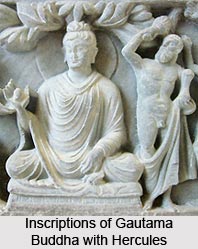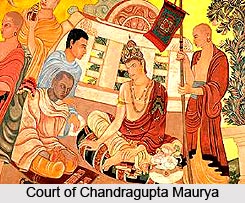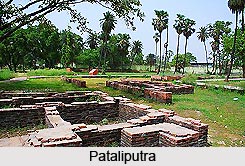 Megasthenese was a Greek scholar who had come in the court of Chandra Gupta as an ambassador of the Greek king Salukus. He remained in India for fourteen years and wrote a famous book named `Indica` in which he has described the different aspect of Indian life of that period. `Indica` has a great historical significance. But a controversy is there among the scholars as to whether the account of Megasthenese can be accepted as authentic or not. His greatest critic was Strabo who observed,
Megasthenese was a Greek scholar who had come in the court of Chandra Gupta as an ambassador of the Greek king Salukus. He remained in India for fourteen years and wrote a famous book named `Indica` in which he has described the different aspect of Indian life of that period. `Indica` has a great historical significance. But a controversy is there among the scholars as to whether the account of Megasthenese can be accepted as authentic or not. His greatest critic was Strabo who observed,
"Generally speaking the men who have written on the affairs of India were a set of liars. Deimachus holds the first place in the list, Megasthenese comes next, no faith whatever can be placed in Deimachus and Megasthenese."
Of course Megasthenese`s description has many defects. In the first place, being a Greek and being ignorant of Indian languages, he had not been able to understand certain special Indian customs. For example, he could not understand the fourfold Varna system and thought it to be a division of labour or works. Secondly, many of his information were based on prevalent rumor and were therefore imaginary and distorted. Thirdly, he had no knowledge of the south and hence his information regarding the south was false. Fourthly, his description shows the mixture of Indian and Greek traditions. Lastly, at several places he has been somewhat careless. For example his contentions that Indians were not acquainted with the written script and written law is completely a false description. Thus it can be seen that there are so many defects in the description of Megasthenese and it needs to be read with great care and caution as well.
Though there are many defects in the description of Megasthenese, yet it cannot be denied that it has great significance. Dr. Smith regards his descriptions as highly authentic. According to him his descriptions is the outcome of his personal knowledge and experience. Megasthenese has observed many incidents of the reign of Chandra Gupta in great detail and has also given a vivid description of the life of the people and administrative organization of that period. His description on different aspects of Indian life is given below under following heads.
Geographical condition
According to Megasthenese the construction of India is like a quadrangle. The empire of Chandra Gupta extended to Afghanistan. He has also described the rivers of Afghanistan. He writes that it is very hot in India during summer season. It rains both in summer and winter seasons but he also mentioned that it rains heavily during the summer season.
Social conditions
Megasthenese has written a vivid description of the social conditions of the people in the reign of Chandra Gupta. According to Megasthenese the society was divided into seven parts that can be mentioned as philosophers, councilors, administrators, soldiers, farmers, traders and labourers, and the last one is hunters.
 The caste systems were very rigid and inter caste marriages were not permitted. Regarding eating habits Megasthenese writes that Indians lived frugally. According to him, "They had no fixed hours for eating and generally ate alone. Slavery was unknown." However, this view of Megasthenese cannot be accepted because slavery was prevalent in India during the reign of Chandra Gupta. However, slaves were not treated as badly as they were treated in Greece. Megasthenese further writes that people led a moral life and loved truth. Thefts and other crimes were very rare in the society and the people left their houses unlocked. People wore costly dresses and their standard of living was very high. On sacrificial occasions people drank samaras. The people were handsome, healthy and of high stature. The status of women was high in the society. However, polygamy was prevalent in aristocratic families. Megasthenese also speaks of certain strange things such as there were tribes whose height was not more than a yard. There were persons having only one eye in the middle of their head and there were persons without nostrils. These accounts are very fantastic and appear to be completely false. It is on account of these descriptions Strabo calls Megasthenese a liar and considers his accounts as `full of fables.`
The caste systems were very rigid and inter caste marriages were not permitted. Regarding eating habits Megasthenese writes that Indians lived frugally. According to him, "They had no fixed hours for eating and generally ate alone. Slavery was unknown." However, this view of Megasthenese cannot be accepted because slavery was prevalent in India during the reign of Chandra Gupta. However, slaves were not treated as badly as they were treated in Greece. Megasthenese further writes that people led a moral life and loved truth. Thefts and other crimes were very rare in the society and the people left their houses unlocked. People wore costly dresses and their standard of living was very high. On sacrificial occasions people drank samaras. The people were handsome, healthy and of high stature. The status of women was high in the society. However, polygamy was prevalent in aristocratic families. Megasthenese also speaks of certain strange things such as there were tribes whose height was not more than a yard. There were persons having only one eye in the middle of their head and there were persons without nostrils. These accounts are very fantastic and appear to be completely false. It is on account of these descriptions Strabo calls Megasthenese a liar and considers his accounts as `full of fables.`
Description of Patuliputra
Megasthenese has described Patuliputra, which was the capital of Chandra Gupta. He has given the description in great details. Situated on the confluence of rivers Ganges and sone, it was nine miles long and quarter to two miles wide. The city was protected by a moat that was 600 ft. wide and had a depth of 60 ft. A massive timber pallisade, which had 64 gates and 570 towers, further protected the city. To administer the city there was a council of thirty members which were further divided into six boards with five members each. The following six boards were there to administer the city. V.i.z. board of industries, board for foreigners, board of census, board for trade and commerce, board for manufacturing goods, and board for taxes.
These boards and the councils of thirty members were collectively responsible for the whole administration of the city.
Other cities
Megasthenese has also mentioned other cities such as Taxila, Ujjain, Kaushambi etc. He writes that these cities used to be near to rivers or sea. Mostly wood was used in the construction of the buildings. However, more lime and bricks were used in the cities, which were at high altitudes.
The king and his palace
According to the description of Megasthenese, the king lived with great pomp and show. To protect his life there was a fine network of spies, which also included some efficient women. To foil the attempt on his life Chandra Gupta did not sleep in the same room for more than one night. He moved out of palace only on some special occasions, such as to hear cases, for hunting and for offering obligations to the gods etc.
 Megasthenese has given a very beautiful and vivid description of the royal palace and the court of Chandra Gupta. According to him the royal palace of Chandra Gupta was far more splendid than those of the Persian kings. Megasthenese writes that the royal palace was within an extensive part. He further writes, "The park was full of tame peacocks and pheasants shady groves and trees set in clumps, with branches, woven together by certain special cunning of horticulture, trees that are always green, that never grow old and never shed leaves, some of them are native and some are brought from other lands with great care, and these adorn the palace and give it glory. Birds are there free and unconfined. They come of their own accord and have their nests and resting places in the branches, birds of various kinds. In this royal palace, there are lovely tanks made by men, in which they kept fish of enormous size, but quite tame. No one has permission to fish except the king`s sons while yet in their boyhood they also learnt-how to sail boats."
Megasthenese has given a very beautiful and vivid description of the royal palace and the court of Chandra Gupta. According to him the royal palace of Chandra Gupta was far more splendid than those of the Persian kings. Megasthenese writes that the royal palace was within an extensive part. He further writes, "The park was full of tame peacocks and pheasants shady groves and trees set in clumps, with branches, woven together by certain special cunning of horticulture, trees that are always green, that never grow old and never shed leaves, some of them are native and some are brought from other lands with great care, and these adorn the palace and give it glory. Birds are there free and unconfined. They come of their own accord and have their nests and resting places in the branches, birds of various kinds. In this royal palace, there are lovely tanks made by men, in which they kept fish of enormous size, but quite tame. No one has permission to fish except the king`s sons while yet in their boyhood they also learnt-how to sail boats."
His court
Regarding the court of Chandra Gupta, Megasthenese described that it was very grand and magnificent. Every object of luxury was available to him. Chandra Gupta had his court with great pomp and show. According to Dr. Spooner the court of Chandra Gupta resembled with that of the Persian court. Curtius had also described the grandeur of the court of Chandra Gupta. On this account he writes,
"When the king condescends to show himself in public, his attendants carry in their hands silver censors and perfume with incense all the road by which it is his pleasure to be conveyed. He lolls in a golden palanquin, garnished with pearls which dangle all round it; and he is robed in fine muslin embroidered with purple and gold. Behind his palanquin follow men-in-arms and his bodyguards of who carry boughs of trees on which birds are perched, trained to interpret business with their cries."



















